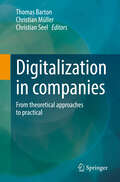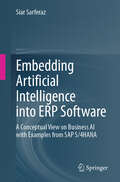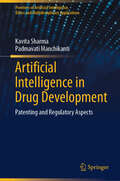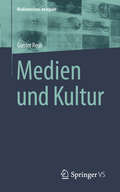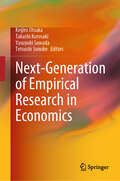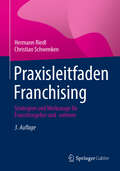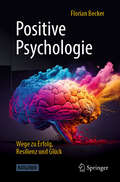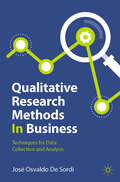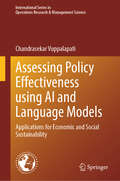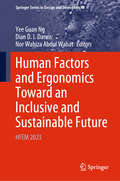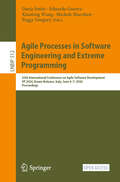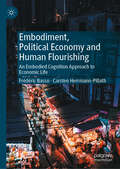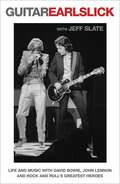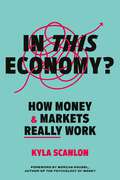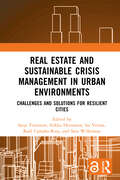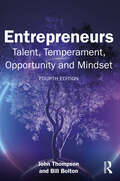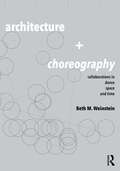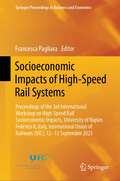- Table View
- List View
Digitalization in companies: From theoretical approaches to practical
by Thomas Barton Christian Müller Christian SeelThe book conveys current approaches to digitization in companies and shows how digitization projects can be successfully and safely implemented in practice. Based on the description of a changing value creation and working world, the changes associated with digitization are explained using application scenarios: New business models and business processes are being established, the development of products is changing as is the interaction with customers, new opportunities but also new risks are emerging. The authors of the article present the basics as well as concepts for the concrete planning and implementation of the digitization of processes and applications. Aspects of IT security are not neglected either. The editors' work is based on questions from entrepreneurial practice and is also suitable for students and teachers.
Photocatalysis for Energy and Environmental Applications: Current Trends and Future Perspectives (Green Energy and Technology)
by Panneerselvam SathishkumarThis book presents the existing photocatalytic reactor design and the future developments and the progress needed for both solar light-driven hydrogen generation and environmental purification. The chapters discuss the renewable and commercial aspects of translucent polymer-linked heterojunction nanocomposites as visible light-responsive photocatalysts. Relevant to these areas, the field of growing interest in black-TiO2, perovskites, MXenes and their numerous applications are presented. The framework, structural features and the need of mesocrystals for solar light-driven photocatalysis are also included. The book also discusses the additional features of green chemistry-based synthesis of nanomaterials in order to reduce any secondary pollution that may be released in the environment due to unsafe disposal of solvents. In addition, the importance of bismuth-based nanophotocatalysts towards energy and environmental applications and their future development as alternative photocatalysts for the prevailing nanomaterials are presented. The book also touches upon the idea to generate green fuel hydrogen through photocatalytic and photoelectrochemical techniques. Overall the book highlights contemporary developments in the last decade, the future perspectives of photocatalysis and its application towards energy and environment.
Embedding Artificial Intelligence into ERP Software: A Conceptual View on Business AI with Examples from SAP S/4HANA
by Siar SarferazThis book explains how to embed artificial intelligence in digitized business processes of ERP software by solving the two related substantial challenges: how can artificial intelligence be systematically integrated into ERP business processes for ease of consumption, and how can artificial intelligence be made enterprise-ready by covering ERP qualities like compliance, lifecycle management, extensibility, or scalability? As a general introduction, the first part of this book takes the reader through a historical journey towards intelligent ERP systems. In addition, reference processes and a reference architecture for ERP systems are proposed which build the foundation for the suggested subsequent solution concept, including a method for operationalizing intelligence for ERP business processes. Subsequently, in the second part detailed concepts of embedding artificial intelligence into ERP software are proposed. In this context the suggested solution architecture is depicted, and specific topics are resolved like data integration, model validation, explainability, data protection and privacy, model degradation and performance. In the last part an implementation framework is suggested which enables the previously introduced concepts and harmonizes the development and operations of artificial intelligent ERP applications. This part concludes with case studies considering artificial intelligence scenarios of SAP S/4HANA in the areas of logistics, finance and sales which apply the defined solution approach and shows its real-world feasibility. This book is written for professionals who want to implement (as developers) or exploit (as business analysts or consultants) or consider/plan the implementation/exploitation (as managers) of artificial intelligence in business information systems.
Artificial Intelligence in Drug Development: Patenting and Regulatory Aspects (Frontiers of Artificial Intelligence, Ethics and Multidisciplinary Applications)
by Kavita Sharma Padmavati ManchikantiThis book discusses how Artificial Intelligence developments have revolutionized the area of medicine and how companies use them to develop applications. While the book covers the growth of AI in medicine and the early developments in AI based medical tools, it provides an in-depth analysis of the current developments in relation to the area of medical diagnostics. The book focuses on how enterprises and institutes have developed their intellectual property portfolio, particularly patents, in this area. Cross-country patenting analysis helps in understanding key areas of growth in certain markets and also company strategies and arrangements. The introduction of AI based products in market is subject to regulation. The developments in policy and regulation influence the development and deployment of such products into the market. This book brings focus to the development of policy and regulation and how regulatory developments impact the introduction of AI-based healthcare products from a cross-country perspective. Further, how regulatory developments lead to the evolution of standards, build reliability and safety in this area are also examined. The unique aspect of this book is the comprehensive coverage of the dual aspects of the nature and scope of AI-based innovations in health care and the related drug regulatory aspects which are imperative for the understanding for students, researchers, and those who work in this area.
Medien und Kultur (Medienwissen kompakt)
by Gunter ReusMedien bestimmen unseren Alltag in jeder Lebenslage. Viele Menschen empfinden ihre Macht aber als gefährlich für die gesellschaftliche Kultur. Gunter Reus zeigt dagegen, wie sehr ein Gemeinwesen auf der kulturellen Leistung der Massenmedien aufbaut. Der Autor bedient sich dabei eines weiten Kulturbegriffs und zeichnet nach, wie sie Errungenschaften der Menschheit historisch ausgeformt haben. Ohne Medien gäbe es keine einheitliche Sprache und keinen Austausch von Information und Wissen, wie wir ihn kennen. Es gäbe keine Ausbalancierung sozialer Interessen, keine Kontrolle von Macht, keine Orientierung auf das Gemeinwohl, kein Kunstleben. Auch im Internetzeitalter bleiben Massenmedien, bei aller notwendigen Kritik an ihren Schattenseiten, unverzichtbar als Kulturträger. Sie sorgen für die Transparenz politischen Handelns ebenso wie für die (potentielle) Teilhabe aller am Kunstgeschehen. Damit prägen sie die Kultur der Demokratie wie auch die Kultur in der Demokratie entscheidend mit.
Next-Generation of Empirical Research in Economics
by Keijiro Otsuka Yasuyuki Sawada Tetsushi Sonobe Takashi KurosakiLeading Japanese economists passionately discuss the frontiers of empirical research in economics and the future of it in this book. The book explores the impact that recent econometrics and empirical research has had on labor economics, development economics, international trade theory, behavioral economics, economic history, and macroeconomics. Each chapter consists of a main text, comments, and replies by leading experts in each sub-discipline. Basic knowledge of statistics and qualitative economics is ideal, but not essential to appreciate the book. This book is ideal for students and scholars who wish to learn about cutting-edge empirical research in economics and learn how to apply it to their own research.
Praxisleitfaden Franchising: Strategien und Werkzeuge für Franchisegeber und -nehmer
by Hermann Riedl Christian SchwenkenFranchisesysteme verstehen, systematisch aufbauen und für alle Beteiligten zum Erfolg machen ist ein komplexes Unterfangen. Wie das geht, erfahren Sie in diesem Buch. Franchisegeber wie auch Franchisenehmer erhalten wertvolle Strategien und Tools für das Tagesgeschäft und Antworten auf grundlegende Fragen: Wie können verschiedene Franchisesysteme aus den unterschiedlichsten Perspektiven bewertet werden? Welche Rolle spielen Regelwerke und deren Inhalte dabei? Wie funktionieren die verschiedenen Prozesse und wie kann die Zusammenarbeit erfolgreich verlaufen? Wie können Marketingmaßnahmen im Franchisesystem gesteuert werden?Die Autoren liefern wertvolle und direkt in den Arbeitsalltag integrierbare Werkzeuge und Mustervorlagen u. a. zu Mitbewerberanalysen, Dienstplänen, Personalaudits, Tages- und Umsatzplanungen. Die dritte Auflage wurde überarbeitet und um aktuelle Veränderungen in der Rechtsprechung sowie die Themen Lizenzvertrag versus Franchisevertrag, Gebietsschutz und Scheinselbstständigkeit ergänzt.Ein unverzichtbarer Leitfaden für alle, die praxisnahe Informationen zum Thema Franchising suchen und sofort anwenden wollen.
Qualitative Research Methods In Business: Techniques for Data Collection and Analysis
by José Osvaldo De SordiThe challenges of developing research and generating scientific knowledge in environments that involve subjective aspects related to employees, customers, managers, leaders, inspectors, auditors, among other stakeholders in the business environment, can be overwhelming for students that are new to this type of inquiry. This textbook presents an integrated view of qualitative research strategies with data collection and analysis techniques.The book explores nine distinct research strategies, namely ethnography, phenomenology, grounded theory, case study, design science research, grounded design, action research, participatory action research, and action-design research.Related to data collection, this text discusses different types of qualitative interviews (focus groups, ethnographic, phenomenological, etc), as well as how to handle ethical issues that may arise.In terms of analyzing data, the author describes various reading techniques, how to code the text, and how to use software to aid in the analysis.The final section of the book explains how to write up the results of qualitative research, including article structure and selecting an outlet for publication.Students will benefit from the plentiful examples and exercises that highlight the interweaving of data collection and analysis as well as concrete guidelines on engaging in qualitative research. At a time in which qualitative research is becoming more rigorous to meet the demands of the field, this textbook will prove a valuable resource for the next generation of business researchers.The English translation of this book from its Portuguese original manuscript was done with the help of artificial intelligence (machine translation by the service provider DeepL.com). A subsequent human revision of the content was done by the author.
Assessing Policy Effectiveness using AI and Language Models: Applications for Economic and Social Sustainability (International Series in Operations Research & Management Science #354)
by Chandrasekar VuppalapatiThis volume uses advanced machine learning techniques to analyze government communication to evaluate policy effectiveness. The book develops policy effectiveness foundation models by cohorting historical budget policies with statistical models which are built on well reputed data sources including economic events, macroeconomic trends, and ratings and commerce terms from international institutions. By signal mining policies to the economic outcome patterns, the book aims to create a rich source of successful policy insights in terms of their effectiveness in bringing development to the poor and underserved communities to ensure the spread of wealth, social wellbeing, and standard of living to the common denomination of society rather than a selected quotient. Enabling academics and practitioners across disciplines to develop applications for effective policy interventions, this volume will be of interest to a wide audience including software engineers, data scientists, social scientists, economists, and agriculture practitioners.
Human Factors and Ergonomics Toward an Inclusive and Sustainable Future: HFEM 2023 (Springer Series in Design and Innovation #46)
by Yee Guan Ng Dian D. I. Daruis Nor Wahiza Abdul WahatThis book gathers the refereed proceedings of the 5th HFEM Biennial Conference on Human Factors and Ergonomics, organized by the Human Factors and Ergonomics Society Malaysia, held in Langkawi, Malaysia on August 13–18, 2023. Under the theme "Accelerating Human Factors and Ergonomics Toward an Inclusive and Sustainable Future", it highlights the latest theories and models, as well as cutting-edge technologies and applications on human factors and ergonomics. By combining findings from a range of disciplines including engineering, design, robotics, health care, management, computer science, human biology, and behavioral science, it offers an excellent source of innovative ideas to stimulate future discussions and developments aimed at applying knowledge and techniques to optimize system performance, while at the same time promoting the health, safety, and well-being of individuals. It includes papers from researchers and practitioners, scientists and physicians, institutional leaders, managers, and policy makers that contribute to constructing the human factors and ergonomics approach across a variety of methodologies, domains, and productive sectors.
Agile Processes in Software Engineering and Extreme Programming: 25th International Conference on Agile Software Development, XP 2024, Bozen-Bolzano, Italy, June 4–7, 2024, Proceedings (Lecture Notes in Business Information Processing #512)
by Xiaofeng Wang Peggy Gregory Eduardo Guerra Michele Marchesi Darja ŠmiteThis open access book constitutes the proceedings of the 25th International Conference on Agile Software Development, XP 2024, which took place in Bozen-Bolzano, Italy, during June 04-07, 2024. XP is the premier agile software development conference combining research and practice. It is a unique forum where agile researchers, practitioners, thought leaders, coaches, and trainers get together to present and discuss their most recent innovations, research results, experiences, concerns, challenges, and trends. XP conferences provide an informal environment to learn and trigger discussions and welcome both people new to agile and seasoned agile practitioners. This year’s conference was held with the theme “Reflect, Adapt, Envision”. The 10 full and 2 short papers included in these proceedings were carefully reviewed and selected from 32 submissions. They were organized in topical sections as follows: agile at scale; value and quality in agile; and people and teams in agile.
Embodiment, Political Economy and Human Flourishing: An Embodied Cognition Approach to Economic Life
by Carsten Herrmann-Pillath Frédéric BassoThis book presents embodied economics as a foundational alternative to behavioral economics and other projects integrating economics and psychology inspired by the computational paradigm. The 20th century witnessed the disembodiment of economic models through the intensification of mathematization and formal abstraction in economics. Even proponents of an embodied approach to cognition, such as Hayek, paradoxically championed the abstract market order as a disembodied superhuman intelligence. In the wake of groundbreaking perspectives in cognitive and social sciences, which have helped to rethink the fundamental building blocks of economics, agency and institutions, this title takes a radical turn towards embodiment. Reinstating economics as political economy, embodied economics motivates a critique of capitalism based on the analysis of disembodiment through abstraction and reactivates key critical insights into the anthropology put forward by the young Marx about contemporary economics and its conceptualizations of money, property, and labor. Based on this analysis, the authors envision a concrete utopia for an economic order centered on human dignity and care for life on Earth. This book contributes to recent discussions about behavioral, experimental and neuroeconomics and addresses a transdisciplinary audience in the social and behavioral sciences, philosophy, and the humanities.
Guitar: A rock 'n' roll tell-all autobiography from David Bowie's sideman
by Jeff Slate Earl SlickRead this rollicking rock 'n' roll memoir of the last 50 years of rock history, from David Bowie's longest serving lead guitarist and legendary sideman, Earl Slick. He's played with everyone from John Lennon to the New York Dolls – and he's got the stories to prove it.----‘Earl is a legendary guitar star. His playing is earth, timeless and never less than stellar’ DAVID BOWIE ‘You play mean ass blues for a skinny ass white boy’ BUDDY GUY ‘Had a good night out did we . . .?’ JOHN LENNON Earl Slick was barely out of his teens when David Bowie hired him to play guitar on the ground-breaking 1974 Diamond Dogs tour. It marked the beginning of a relationship that would endure through thick and thin for the next forty years. Gracing classic albums like Young Americans, Station to Station and the 2013 comeback, The Next Day, Slick played on the tour that followed Bowie’s smash hit Let’s Dance album and was at his side for the epic Glastonbury show in 2000. But it wasn’t just Bowie. The young guitarist was in John Lennon’s band at the time of the former Beatle’s tragic murder. Other collaborations read like a roll call of rock ‘n’ roll royalty including Mick Jagger, The Cure, George Harrison, Ringo Starr, Joe Cocker, Buddy Guy, Ian Hunter, David Coverdale and Eric Clapton. And in the ‘80s he became an MTV star in his own right with the success of Phantom, Rocker and Slick. Through it all he lived the rock ‘n’ roll life to the hilt. Until it nearly killed him. One of rock’s great sidemen, Earl Slick was in the room when music history was made. Guitar takes us there, shining a light on superstars like Bowie and Lennon, while recounting the extraordinary story of the boy from New York City who became a real-life Johnny B. Goode.
In This Economy?: How Money and Markets Really Work
by Kyla Scanlon"Few people can communicate how the economy actually works better than Kyla Scanlon." -Morgan Housel, author of The Psychology of MoneyThe stuff you really need to know about how the economy works? It's pretty simple. Yes, even if you were bored to tears in economics class, or if you're cross-eyed from reading painfully convoluted-or straight-up misguided-financial commentary. In this particularly disorienting era, Kyla Scanlon is the Tim Harford of the disaffected and disillusioned Gen Z looking for answers.This is the definitive, approachable guide to the key concepts and mechanics of economics and the most common myths and fallacies to steer clear of. Through Kyla's trademark blend of creative analogies, clever illustrations, refreshingly lucid language-and even quotes from poetry, literature, and philosophy-she answers questions such as:- Is our national debt really a threat?- What is a "mild" recession, exactly?- What's really happening in the employment market, and how do we improve it for workers?At a time when experts overcomplicate simple things loudly, choosing to generate smoke rather than clearing the air, In This Economy? shows that understanding the markets-and the systems they operate in-is easier than you think.Whether you're worried about your mortgage rate, job security, bank account balance, or the health of the broader economy, this concise and witty guide will give you the confidence to make smarter financial decisions-no matter what the headlines say.
Real Estate and Sustainable Crisis Management in Urban Environments: Challenges and solutions for resilient cities
by Sara Wilkinson Saija Toivonen Sirkka Heinonen Ira Verma Raúl Castaño-RosaThe aim of this book is to promote the dynamic resilience of societies by identifying, analysing, and exemplifying the role of space and land use in both anticipated and unanticipated primary and secondary crisis situations. The book brings together the expertise of a unique team of researchers and methods from fields of futures studies, land use planning, social sustainability and wellbeing, architecture, spatial planning, design and real estate economics, and presents a novel understanding of the direct and indirect impacts of possible crises in the space and land use context. It goes on to discuss the concept of resilience and exemplifies potential solutions and offers a holistic and forward-looking approach for crisis management through a lens of social sustainability and wellbeing, making an important contribution to the promotion of wellbeing in the built environment, especially in terms of land and residential space and building use. This book does not only identify barriers and successful incentives in resilient crisis management but also discusses the role of different stakeholders (e.g., households, office workers, real estate owners, space occupants, firms, the public sector, etc.) in crisis management. Finally, international case studies aiming to tackle the challenging landscape of future threats are presented, along with novel tools to support the development of future policies, regulations, and management practices in the built environment, which can increase the dynamic resilience of societies. Overall, this book is essential reading for decision-makers in the public and private sectors, urban developers, space and spatial designers, architects, planners, community stakeholders, real estate investors, facility managers and crisis and corporate responsibility managers.
Real Estate and Sustainable Crisis Management in Urban Environments: Challenges and solutions for resilient cities
by Sara Wilkinson Saija Toivonen Sirkka Heinonen Ira Verma Raúl Castaño-RosaThe aim of this book is to promote the dynamic resilience of societies by identifying, analysing, and exemplifying the role of space and land use in both anticipated and unanticipated primary and secondary crisis situations. The book brings together the expertise of a unique team of researchers and methods from fields of futures studies, land use planning, social sustainability and wellbeing, architecture, spatial planning, design and real estate economics, and presents a novel understanding of the direct and indirect impacts of possible crises in the space and land use context. It goes on to discuss the concept of resilience and exemplifies potential solutions and offers a holistic and forward-looking approach for crisis management through a lens of social sustainability and wellbeing, making an important contribution to the promotion of wellbeing in the built environment, especially in terms of land and residential space and building use. This book does not only identify barriers and successful incentives in resilient crisis management but also discusses the role of different stakeholders (e.g., households, office workers, real estate owners, space occupants, firms, the public sector, etc.) in crisis management. Finally, international case studies aiming to tackle the challenging landscape of future threats are presented, along with novel tools to support the development of future policies, regulations, and management practices in the built environment, which can increase the dynamic resilience of societies. Overall, this book is essential reading for decision-makers in the public and private sectors, urban developers, space and spatial designers, architects, planners, community stakeholders, real estate investors, facility managers and crisis and corporate responsibility managers.
Entrepreneurs: Talent, Temperament, Opportunity and Mindset
by John Thompson Bill BoltonWhat does it take to be – or to become – a successful entrepreneur? Are there specific personality types that are best suited to entrepreneurship? And can these types, or rather the attributes that combine to forge them, be learned or acquired? In this book, John Thompson answers these questions – and many more – to let the reader see through the eyes of the entrepreneur. Entrepreneurs: Talent, Temperament, Opportunity and Mindset introduces the world of entrepreneurship from a person-centred perspective. Part 1 builds an understanding of the entrepreneur as a person based on the key factors of talent and temperament – a unique framework for understanding and exploiting entrepreneurial opportunities. Part 1 also explores the entrepreneurial mindset and how it can be honed and strengthened. The process of starting and growing a business is then described in detail in Part 2, which also examines entrepreneurship in the context of opportunity and strategy. Part 3 introduces the infrastructure and environment in which the entrepreneur has to operate and tells the stories of famous entrepreneurs through dozens of case vignettes, including classic figures such as Henry Ford, through to social entrepreneurs and even anti-social entrepreneurs such as Al Capone! This insightful, empirically-based take on the entrepreneur provides students with an accessible and original way into entrepreneurship. Whatever their background, students at all levels will value the author’s accessible writing style and invaluable insights.
Entrepreneurs: Talent, Temperament, Opportunity and Mindset
by John Thompson Bill BoltonWhat does it take to be – or to become – a successful entrepreneur? Are there specific personality types that are best suited to entrepreneurship? And can these types, or rather the attributes that combine to forge them, be learned or acquired? In this book, John Thompson answers these questions – and many more – to let the reader see through the eyes of the entrepreneur. Entrepreneurs: Talent, Temperament, Opportunity and Mindset introduces the world of entrepreneurship from a person-centred perspective. Part 1 builds an understanding of the entrepreneur as a person based on the key factors of talent and temperament – a unique framework for understanding and exploiting entrepreneurial opportunities. Part 1 also explores the entrepreneurial mindset and how it can be honed and strengthened. The process of starting and growing a business is then described in detail in Part 2, which also examines entrepreneurship in the context of opportunity and strategy. Part 3 introduces the infrastructure and environment in which the entrepreneur has to operate and tells the stories of famous entrepreneurs through dozens of case vignettes, including classic figures such as Henry Ford, through to social entrepreneurs and even anti-social entrepreneurs such as Al Capone! This insightful, empirically-based take on the entrepreneur provides students with an accessible and original way into entrepreneurship. Whatever their background, students at all levels will value the author’s accessible writing style and invaluable insights.
Architecture and Choreography: Collaborations in Dance, Space and Time
by Beth WeinsteinArchitecture and Choreography: Collaborations in Dance, Space and Time examines the field of archi-choreographic experiments—unique interdisciplinary encounters and performed events generated through collaborations between architects and choreographers.Forty case studies spanning four decades give evidence of the range of motivations for embarking on these creative endeavors and diverse conceptual underpinnings, generative methods, objects of inquiry, and outcomes. Architecture and Choreography builds histories and theories through which to examine these works, the contexts within, and processes through which the works emerged, and the critical questions they raise about ways to work together, sites and citations, ethics and equity, control and agency. Three themes frame pairs of chapters. The first addresses disciplinarity through works that critically reflect upon their discipline’s tools, techniques, and conventions juxtaposed against projects that cite or use other art forms and cultural phenomena as source material. The second interrogates space and the role of spatial dispositifs, institutions, and sites, and their hidden and not-so-hidden conditions, as conceptual drivers and structures to subvert, trouble, unsettle, remember. The third asks who and what dances, finding a spectrum from mobilized architectural bodies to more-than-human cybarcorps. Modes of collaboration and the temporalities and life cycles of projects inform bookending chapters.Architecture and Choreography offers vital lessons not only for architects and choreographers but also for students and practitioners across design and performance fields.
Architecture and Choreography: Collaborations in Dance, Space and Time
by Beth WeinsteinArchitecture and Choreography: Collaborations in Dance, Space and Time examines the field of archi-choreographic experiments—unique interdisciplinary encounters and performed events generated through collaborations between architects and choreographers.Forty case studies spanning four decades give evidence of the range of motivations for embarking on these creative endeavors and diverse conceptual underpinnings, generative methods, objects of inquiry, and outcomes. Architecture and Choreography builds histories and theories through which to examine these works, the contexts within, and processes through which the works emerged, and the critical questions they raise about ways to work together, sites and citations, ethics and equity, control and agency. Three themes frame pairs of chapters. The first addresses disciplinarity through works that critically reflect upon their discipline’s tools, techniques, and conventions juxtaposed against projects that cite or use other art forms and cultural phenomena as source material. The second interrogates space and the role of spatial dispositifs, institutions, and sites, and their hidden and not-so-hidden conditions, as conceptual drivers and structures to subvert, trouble, unsettle, remember. The third asks who and what dances, finding a spectrum from mobilized architectural bodies to more-than-human cybarcorps. Modes of collaboration and the temporalities and life cycles of projects inform bookending chapters.Architecture and Choreography offers vital lessons not only for architects and choreographers but also for students and practitioners across design and performance fields.
Socioeconomic Impacts of High-Speed Rail Systems: Proceedings of the 3rd International Workshop on High-Speed Rail Socioeconomic Impacts, University of Naples Federico II, Italy, International Union of Railways (UIC), 12–13 September 2023 (Springer Proceedings in Business and Economics)
by Francesca PagliaraThis book offers new insights into the wider socio-economic impacts of high-speed rail (HSR). Over the past few decades, significant investments have been made in these systems around the world. The use of public funds for the construction of high-speed rail offers a range of benefits, such as time savings, increased comfort, and reduced traffic congestion, as well as broader economic benefits, including the advancement of less developed regions. These proceedings feature papers presented at the 3rd International Workshop on the Socioeconomic Impacts of High-Speed Rail. The focus is on HSR impacts on the environment, on the land use system, on investment, on the tourism industry, on inclusion and on cooperation vs integration with other transport modes. The book provides an overview of the current state of practice from both theoretical and empirical perspectives. Consequently, it will be of interest to scholars of transportation economics and related fields, as well as transportation industry professionals.
Besonderheiten der Sportbetriebslehre
by Heinz-Dieter Horch Manfred Schubert Stefan WalzelBezugspunkt dieses Lehrbuches sind die vielfältigen Besonderheiten von Sportgütern, -institutionen und -betrieben aller Art, die diese von dem der allgemeinen Betriebswirtschaftslehre implizit zugrunde liegenden Modell der Sachgüter produzierenden, gewinnorientierten Großbetriebe unterscheiden. Den Ausgangspunkt bilden dabei jeweils die Grundlagen der relevanten Wissenschaften, wie der Ökonomie, der Betriebswirtschaftslehre oder des Marketings etc. Das Lehrbuch richtet sich an Studierende, ist aber auch für interessierte Praktiker:innen geeignet.Eine einheitliche konzeptionelle Grundlage und der didaktische Aufbau mit kurzen Inhaltsübersichten und Lernzielen zu Beginn eines jeden Kapitels sowie Zusammenfassungen, Wiederholungsfragen und Hinweisen zu weiterführender Literatur am Ende der Kapitel erleichtern die erfolgreiche Nutzung des Lehrbuchs.Für die zweite Auflage wurde eine übersichtliche Aufteilung der Inhalte in drei Teile vorgenommen. Einneues Kapitel zu den Besonderheiten der Finanzierung im Sport wurde integriert, alle anderen Kapitel wurden überarbeitet und aktualisiert.Zusätzliche Fragen per App: Laden Sie die Springer-Nature-Flashcards-App kostenlos herunter und nutzen Sie exklusives Zusatzmaterial, um Ihr Wissen zu prüfen.
Inflation Decade, 1910—1920: Americans Confront the High Cost of Living
by David I. MacleodThis book shows how inflation can disrupt politics and society. With no recent precedent, mild inflation spurred mass protests, myriad remedial schemes, and partisan political reversals between 1910 and 1914. Then wartime demand and inflationary fiscal policy doubled consumer prices from 1915 to 1920, triggering waves of strikes, food riots by immigrant housewives, class conflict, and elite fears of revolution. Middle-class households resented falling real incomes. Even more than today, food prices dominated consumer concerns. Yet farmers wanted high commodity prices. Accordingly, both sides blamed and attacked meatpackers, wholesalers, and retailers. Then as now, inflation hurt whichever party held the White House. Fumbling responses by Wilson’s administration and the Federal Reserve led to hesitant price controls, punitive raids and prosecutions, and a now-familiar fallback—high interest rates in 1920 and subsequent recession. An epilogue traces continuing popular and politicalresponses to changes in the consumer price index down to 2020.
Quick Guide Compliance, ESG und Investigations in Emerging Markets: Ein Leitfaden für Praktiker (Quick Guide)
by Roland Falder Constantin Frank-Fahle Anna-Luisa LemmerzDieser Quick Guide gibt einen Überblick über Compliance, ESG und Investigations in Emerging Markets im Kontext wachsender Anforderungen wie des deutschen Lieferkettensorgfaltspflichtengesetzes und EU-Verordnungen. Deutsche Unternehmen sind durch neue Regelungen, besonders in Emerging Markets, mit verstärkten Sorgfalts-, Dokumentations- und Berichterstattungspflichten konfrontiert. Dieser Leitfaden beleuchtet diese Herausforderungen und zeigt, wie On-Site Audits effizient durchgeführt werden können.Der Inhalt:EinführungAnknüpfungspunkte: Due Diligence, Supply Chain Compliance, Nachhaltigkeitsberichterstattung, KorruptionsvermeidungBetroffene Kreise: Unternehmen, Tochtergesellschaften, Zulieferer, DritteOrganisation von On-Site AuditsZusammenfassung und AusblickDie ZielgruppenCEOs, CFOs, Rechtsabteilungsleiter, Compliance-Beauftragte, Beschaffungsmitarbeiter, Rechtsanwälte
